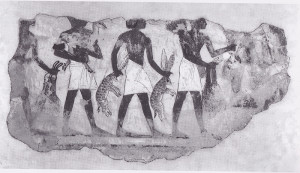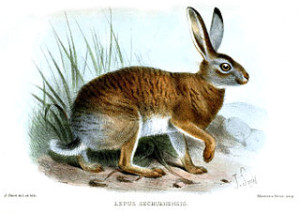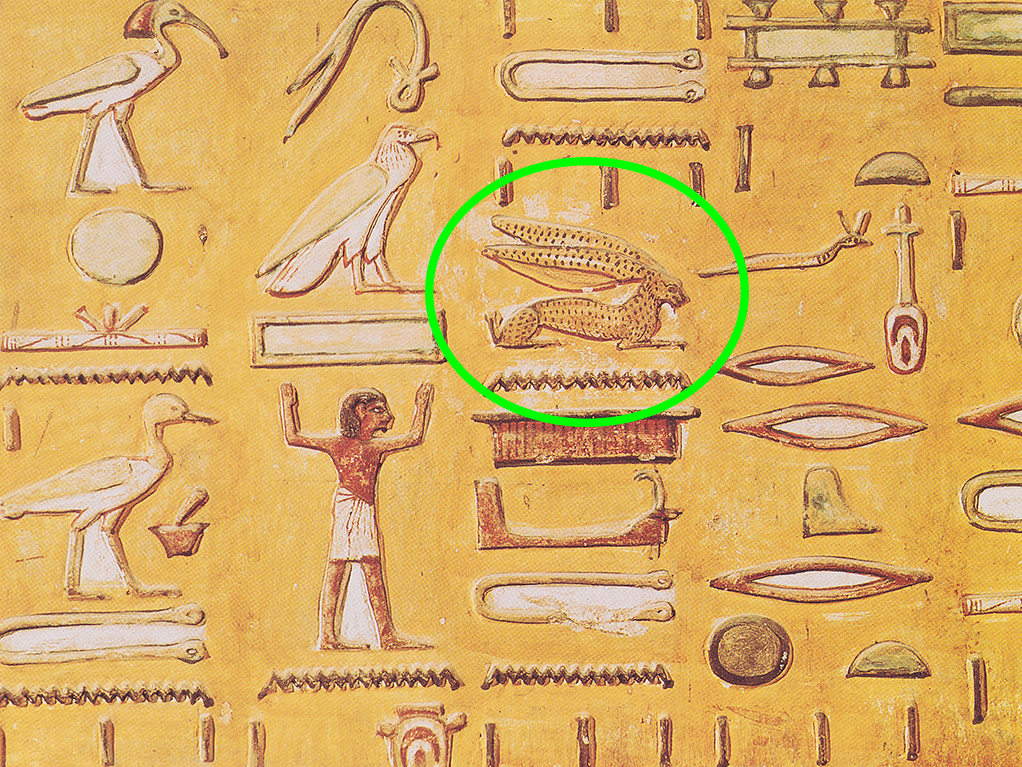If you’re wondering who Wenut is (and most people are), this is the name of the Egyptian hare goddess.
The Egyptians had a hare goddess?
Yes, her name is also spelled Wenet, if that clarifies things for you.
Wenut is considered an obscure goddess, and she gets little or no mention in my library of books on ancient Egypt, not even the books on animals or goddesses. Yet I have seen a fair number of leporids in Egyptian art, usually presented without explication. In some cases I am not sure that I’m really looking at a hare, because the desert foxes also have long ears, and the Jungle Cat is sometimes drawn with exaggerated ears to distinguish it from the Libyan Wildcat. Yet Egyptian drawing conventions are so standardized that I’m confident that most of these long-eared creatures are hares.
One explanation for the ubiquity of the hare is that it is the hieroglyph for a common verb or sound. For example, Hilary Wilson in Understanding Hieroglyphs writes that the symbol for the hare corresponds to the sound wen and is the verb for “being.” To me this explanation begs the question. Why would the hare correspond to a common verb if it were unimportant?
Furthermore, one of the provinces in northern Egypt was called Hare, and the city of Hermopolis within this province had a hare as its emblem. Hermopolis had the main temple to Wenut.
The litmus test for whether an animal (or anything else) had religious importance in Egypt is its presence in funerary materials, and here, too, the hare does not disappoint. Hares appear as votive offerings, and are mentioned in funerary texts as well as illustrations accompanying those texts. Spell 17 of The Book of the Dead says the “Swallower of Myriads” lives in the Lake of Wenut. There are other references to Wenut in the Book of the Dead and the Coffin Texts. Wenut is not prominent in funerary literature, to be sure, but neither is she trivial.
Meditating on Wenut, whose name means “the swift one,” is a reflection on the meaning of obscurity, for hares with their genius for camouflage have a tendency to hide in plain sight. Understanding Egyptian mysteries requires extraordinary perspicacity, because what is important is not so much hidden as overlooked.
March is a March Hare
Online Webinar
Monday, March 9, 2015
7:00 Eastern Time (Daylight Savings)
Cost $25
Webinar will be recorded
Sources
Dunn, Jimmy. “El-Ashmuneim (Ancient Hermopolis)” in Tour Egypt. http://www.touregypt.net/featurestories/hermopolis.htm
Germond, Philippe. An Egyptian Bestiary: Animals in Life and Religion in the Land of the Pharaohs. Barbara Mellor, trans. London: Thames and Hudson, 2001.
Houlihan, Patrick F. The Animal World of the Pharaohs. London: Thames and Hudson, 1996.
Iles, Linda. “Wenet the Swift One” in Mirror of Isis vol. 5, Samhain 2010. http://mirrorofisis.freeyellow.com/id599.html

Lesko, Barbara. The Great Goddesses of Egypt. Norman, OK: The University of Oklahoma Press, 1999.
Wilson, Hilary. Understanding Hierogyphs: A Complete Introductory Guide. London: Brockhampton Press, 1993.

